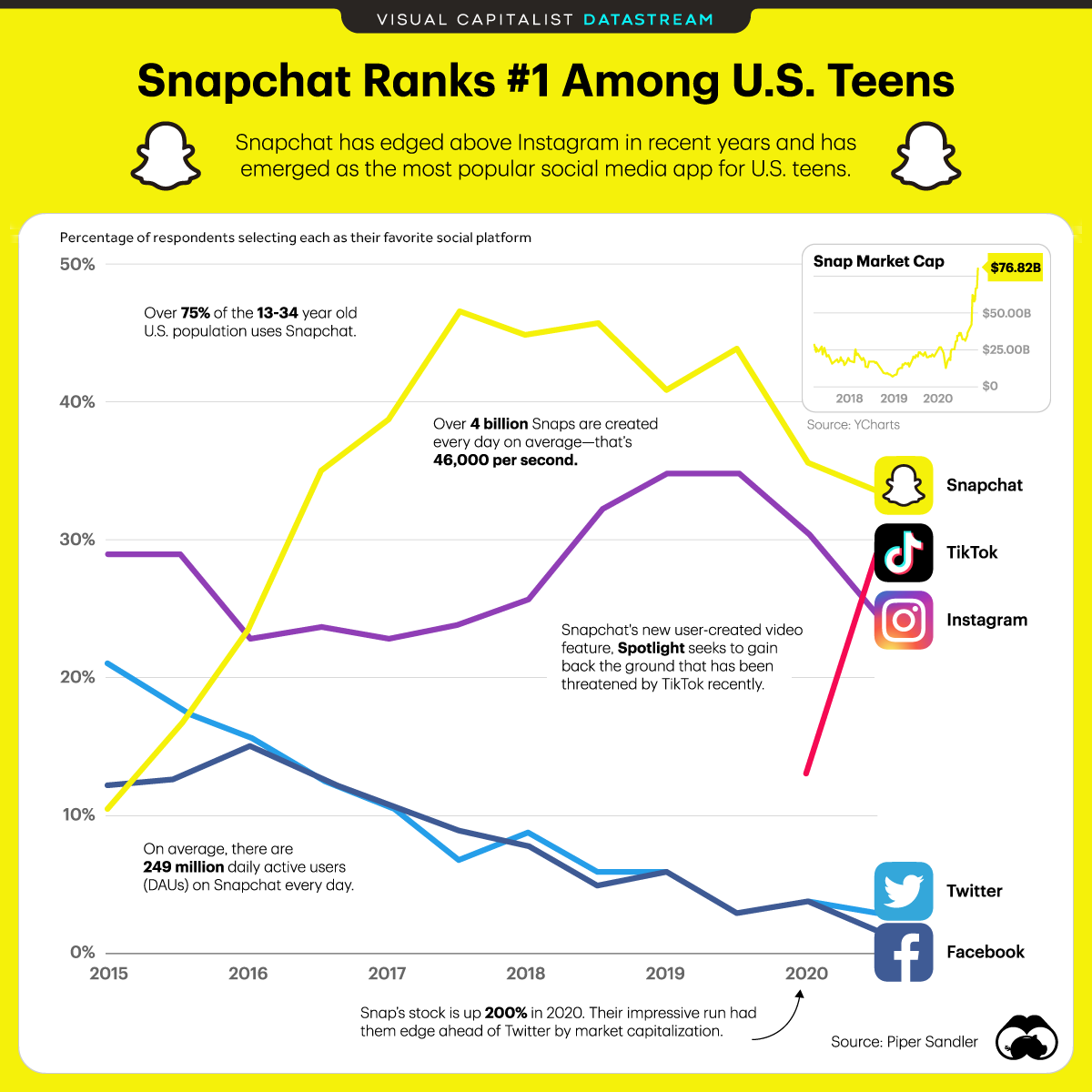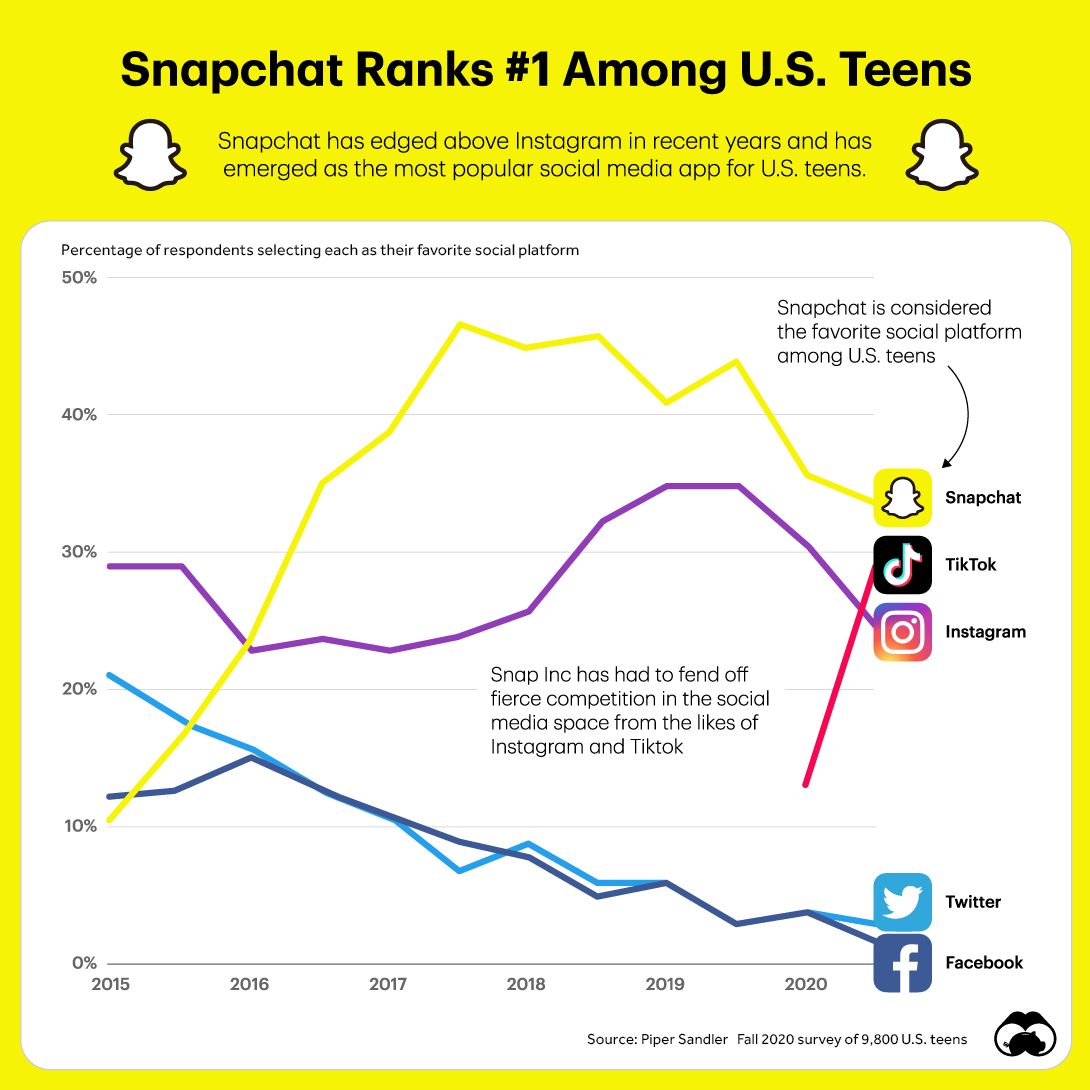Datastream
Snapchat: The Most Popular Social Media Among U.S. Teens

The Briefing
- Snapchat is the most popular social media app among U.S. teens
- 34% of teen respondents picked Snapchat as their favorite platform, compared to 29% who chose TikTok, and 25% who chose Instagram
Snapchat: The Most Popular Social Media Among U.S. Teens
The teens have spoken, and they’ve chosen Snapchat as their favorite social media platform.
When asked to pick their favorite social media platform in a recent survey, more than a third chose Snapchat:
| Social Media Platform | % Who Chose the Platform as Their Favorite |
|---|---|
| Snapchat | 34% |
| TikTok | 29% |
| 25% | |
| 3% | |
| 2% |
This is slightly lower than last year when 41% of teens picked Snapchat as their favorite. Despite a small dip, the company still holds its dominance in the U.S. teen market over rivals Instagram and TikTok – at least for now.
Teens are Keeping Snap Alive
Snapchat has Gen Z to thank when it comes to keeping the company afloat. Since Snap’s IPO in 2017, the company has faced a mountain of challenges from competitors, including the rollout of Instagram Stories and ad monetization.
In March 2017, Snap entered the public market at $27 a share, and right off the bat, shares entered a downward spiral. The lows were met at the $5 range in December 2018, -81% from the IPO.
Yet today, potentially thanks to its dedicated U.S. teen fanbase, Snap is at all-time highs. The company is now valued at $73 billion and has managed to convert those same headwinds into considerable tailwinds.
Snap has 249 million daily active users, and their average revenue per user stands at $2.73 as of Q3’20—over double the $1.21 figure in Q1’18.
Where does this data come from?
Source: Piper Sandler’s 40th Semi-Annual Taking Stock With Teens Survey Fall 2020, via Marketing Charts
Notes: 9,800 teens were included in the survey, across 48 U.S. states.
Datastream
Can You Calculate Your Daily Carbon Footprint?
Discover how the average person’s carbon footprint impacts the environment and learn how carbon credits can offset your carbon footprint.

The Briefing
- A person’s carbon footprint is substantial, with activities such as food consumption creating as much as 4,500 g of CO₂ emissions daily.
- By purchasing carbon credits from Carbon Streaming Corporation, you can offset your own emissions and fund positive climate action.
Your Everyday Carbon Footprint
While many large businesses and countries have committed to net-zero goals, it is essential to acknowledge that your everyday activities also contribute to global emissions.
In this graphic, sponsored by Carbon Streaming Corporation, we will explore how the choices we make and the products we use have a profound impact on our carbon footprint.
Carbon Emissions by Activity
Here are some of the daily activities and products of the average person and their carbon footprint, according to Clever Carbon.
| Household Activities & Products | CO2 Emissions (g) |
|---|---|
| 💡 Standard Light Bulb (100 watts, four hours) | 172 g |
| 📱 Mobile Phone Use (195 minutes per day)* | 189 g |
| 👕 Washing Machine (0.63 kWh) | 275 g |
| 🔥 Electric Oven (1.56 kWh) | 675 g |
| ♨️ Tumble Dryer (2.5 kWh) | 1,000 g |
| 🧻 Toilet Roll (2 ply) | 1,300 g |
| 🚿 Hot Shower (10 mins) | 2,000 g |
| 🚙 Daily Commute (one hour, by car) | 3,360 g |
| 🍽️ Average Daily Food Consumption (three meals of 600 calories) | 4,500 g |
| *Phone use based on yearly use of 69kg per the source, Reboxed | |
Your choice of transportation plays a crucial role in determining your carbon footprint. For instance, a 15 km daily commute to work on public transport generates an average of 1,464 g of CO₂ emissions. Compared to 3,360 g—twice the volume for a journey the same length by car.
By opting for more sustainable modes of transport, such as cycling, walking, or public transportation, you can significantly reduce your carbon footprint.
Addressing Your Carbon Footprint
One way to compensate for your emissions is by purchasing high-quality carbon credits.
Carbon credits are used to help fund projects that avoid, reduce or remove CO₂ emissions. This includes nature-based solutions such as reforestation and improved forest management, or technology-based solutions such as the production of biochar and carbon capture and storage (CCS).
While carbon credits offer a potential solution for individuals to help reduce global emissions, public awareness remains a significant challenge. A BCG-Patch survey revealed that only 34% of U.S. consumers are familiar with carbon credits, and only 3% have purchased them in the past.
About Carbon Streaming
By financing the creation or expansion of carbon projects, Carbon Streaming Corporation secures the rights to future carbon credits generated by these sustainable projects. You can then purchase these carbon credits to help fund climate solutions around the world and compensate for your own emissions.
Ready to get involved?
>> Learn more about purchasing carbon credits at Carbon Streaming
-

 Debt1 week ago
Debt1 week agoHow Debt-to-GDP Ratios Have Changed Since 2000
-

 Markets2 weeks ago
Markets2 weeks agoRanked: The World’s Top Flight Routes, by Revenue
-

 Countries2 weeks ago
Countries2 weeks agoPopulation Projections: The World’s 6 Largest Countries in 2075
-

 Markets2 weeks ago
Markets2 weeks agoThe Top 10 States by Real GDP Growth in 2023
-

 Demographics2 weeks ago
Demographics2 weeks agoThe Smallest Gender Wage Gaps in OECD Countries
-

 United States2 weeks ago
United States2 weeks agoWhere U.S. Inflation Hit the Hardest in March 2024
-

 Green2 weeks ago
Green2 weeks agoTop Countries By Forest Growth Since 2001
-

 United States2 weeks ago
United States2 weeks agoRanked: The Largest U.S. Corporations by Number of Employees















